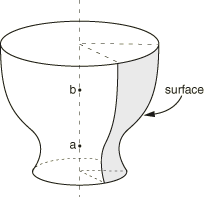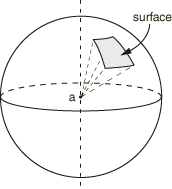*SURFACE SMOOTHING | ||||||
|
| |||||
ProductsAbaqus/StandardAbaqus/CAE
TypeModel data
LevelModel
Abaqus/CAEInteraction module
Required parameters
- NAME
-
Set this parameter equal to a label that will be used to refer to this surface smoothing definition.
This label is referred to by the GEOMETRIC CORRECTION parameter on the CONTACT PAIR option.
![]()
Data lines to define the surface regions on which smoothing is applied
- Data line to define smoothing on regions of two-dimensional surfaces that correspond (or nearly correspond) to a circular arc (see Figure 1)
Name of slave surface or surface corresponding to a subregion of the slave surface. The name can be omitted when smoothing is applied only to a subregion of the master surface.
Name of master surface or surface corresponding to a subregion of the master surface. The name can be omitted when smoothing is applied only to a subregion of the slave surface.
The word CIRCUMFERENTIAL.
Global X-coordinate of point a, the approximate center (origin) of the circular arc.
Global Y-coordinate of point a, the approximate center (origin) of the circular arc.
Figure 1. Two-dimensional circumferential smoothing.
- Data line to define smoothing on regions of surfaces that correspond (or nearly correspond) to a surface of revolution (see Figure 2)
Name of slave surface or surface corresponding to a subregion of the slave surface. The name can be omitted when smoothing is applied only to a subregion of the master surface.
Name of master surface or surface corresponding to a subregion of the master surface. The name can be omitted when smoothing is applied only to a subregion of the slave surface.
The word CIRCUMFERENTIAL.
Global X-coordinate of point a on the approximate axis of revolution for the surface.
Global Y-coordinate of point a on the approximate axis of revolution for the surface.
Global Z-coordinate of point a on the approximate axis of revolution for the surface.
Global X-coordinate of point b on the approximate axis of revolution for the surface (see Figure 2).
Global Y-coordinate of point b on the approximate axis of revolution for the surface.
Global Z-coordinate of point b on the approximate axis of revolution for the surface.
Figure 2. Three-dimensional circumferential smoothing.
- Data line to define smoothing on regions of surfaces that correspond (or nearly correspond) to a sphere section (see Figure 3)
Name of slave surface or surface corresponding to a subregion of the slave surface. The name can be omitted when smoothing is applied only to a subregion of the master surface.
Name of master surface or surface corresponding to a subregion of the master surface. The name can be omitted when smoothing is applied only to a subregion of the slave surface.
The word SPHERICAL.
Global X-coordinate of point a, the approximate center (origin) of the sphere.
Global Y-coordinate of point a, the approximate center (origin) of the sphere.
Global Z-coordinate of point a, the approximate center (origin) of the sphere.
Figure 3. Spherical smoothing.
- Data line to define smoothing on regions of surfaces that correspond (or nearly correspond) to a toroidal surface (see Figure 4)
Name of slave surface or surface corresponding to a subregion of the slave surface. The name can be omitted when smoothing is applied only to a subregion of the master surface.
Name of master surface or surface corresponding to a subregion of the master surface. The name can be omitted when smoothing is applied only to a subregion of the slave surface.
The word TOROIDAL.
Global X-coordinate of point a on the approximate axis of revolution for the surface (see Figure 4).
Global Y-coordinate of point a on the approximate axis of revolution for the surface.
Global Z-coordinate of point a on the approximate axis of revolution for the surface.
Global X-coordinate of point b on the approximate axis of revolution for the surface (see Figure 4).
Global Y-coordinate of point b on the approximate axis of revolution for the surface.
Global Z-coordinate of point b on the approximate axis of revolution for the surface.
Distance R of the center of the circular arc from the axis of revolution (see Figure 4).
Repeat the above data lines as often as necessary to define all surface regions that require smoothing.
